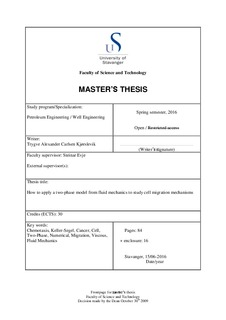| dc.contributor.advisor | Evje, Steinar | |
| dc.contributor.author | Kjørslevik, Trygve Alexander Carlsen | |
| dc.date.accessioned | 2016-09-19T13:53:30Z | |
| dc.date.available | 2016-09-19T13:53:30Z | |
| dc.date.issued | 2016-06-15 | |
| dc.identifier.uri | http://hdl.handle.net/11250/2408387 | |
| dc.description | Master's thesis in Petroleum engineering | nb_NO |
| dc.description.abstract | The classical Keller-Segel model of cell migration due to random motion and chemotaxis,
has, as a result of its intuitive simplicity and ability to replicate key behavior of chemotactic
populations, provided a foundation for much of the work with respect to mathematical
modeling of chemotaxis. In this thesis, a generalized two-fluid version of this model, based
on the works of Evje andWen [16] and Byrne and Owen [6] will be derived using a multiphase
modeling approach proposed in [6], describing how a population of cells moves through
a fluid containing a diffusible chemical to which the cells are attracted. In the proposed
multiphase setting, the cell and fluid are viewed upon as components of a two-phase system,
and principles of mass and momentum balance are then applied to each phase, in addition
to appropriate closure laws. The characteristic behavior of the model and its ability to
replicate experimental observations of cancer cells made by Cheng et al. in [9] has then been
investigated by performing numerical simulations with varying input parameters. Some of
the key findings include that the model shows a good ability to generate spatial patterns, but
compared to the experimental data in [9], the kinematic viscosity and cell compressibility
had to be chosen unrealistically high and low, respectively, in order to get a good match to
the experimental results. The model also shows a high sensitivity to initial data, while the
choice of boundary geometry (circle or square) does not seem to have any impact on the
computed solution, given that the cell phase not comes in direct contact with the boundary.
Further, we found that the shear stress terms play an important role in how the solution will
evolve with time, both with respect to shape and rate of change. The information attributed
to these terms are however lost when using numerical solution methods such as dimensional
splitting. | nb_NO |
| dc.language.iso | eng | nb_NO |
| dc.publisher | University of Stavanger, Norway | nb_NO |
| dc.relation.ispartofseries | Masteroppgave/UIS-TN-IPT/2016; | |
| dc.rights | Navngivelse 3.0 Norge | * |
| dc.rights.uri | http://creativecommons.org/licenses/by/3.0/no/ | * |
| dc.subject | petroleum technology | nb_NO |
| dc.subject | petroleumsteknologi | nb_NO |
| dc.subject | chemotaxis | nb_NO |
| dc.subject | cancer | nb_NO |
| dc.subject | well engineering | nb_NO |
| dc.subject | brønnteknologi | nb_NO |
| dc.subject | fluid mechanics | nb_NO |
| dc.subject | cell migration | nb_NO |
| dc.subject | Keller-Segel model | nb_NO |
| dc.title | How to apply a two-phase model from fluid mechanics to study cell migration mechanisms | nb_NO |
| dc.type | Master thesis | nb_NO |
| dc.subject.nsi | VDP::Technology: 500::Rock and petroleum disciplines: 510::Petroleum engineering: 512 | nb_NO |

